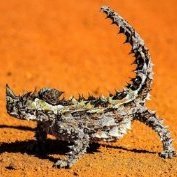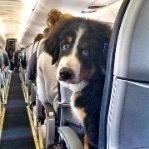
checksix
-
Posts
50 -
Joined
-
Last visited
-
Days Won
1
Reputation Activity
-
 checksix got a reaction from Martinnfb in 1/72 Rockwell B-1B Lancer ("BONE") bomber
checksix got a reaction from Martinnfb in 1/72 Rockwell B-1B Lancer ("BONE") bomber
Back end
The Barracuda resin exhaust nozzle castings are quite detailed. Installing the tiny actuator rods is a challenge. They are sliced one at a time from the casting block and then CA'd in place. Many spares are provided. I only lost two:
After painting and applying a wash of clear smoke:
-
 checksix got a reaction from Martinnfb in 1/72 Rockwell B-1B Lancer ("BONE") bomber
checksix got a reaction from Martinnfb in 1/72 Rockwell B-1B Lancer ("BONE") bomber
Front end
Rather than using decals, I painted all lines and markings. Window seal outlines were applied using the Barracuda canopy masks. To make a mask for the refueling markers, I scanned the original decal sheet, did some photo editing to generate a black-on-white image, and printed out the image. Then I overlaid some frisket film on the image, traced out the pattern with a fresh X-Acto blade, transferred the film mask onto the model, and sprayed several thin coats of off-white:
The resin pitot tubes are tiny. They are installed into holes that must be drilled. I used the tip of an X-Acto blade to start each hole and then opened them to size with a finger-turned .081" drill bit.
A needle file was used to ream out each hole for a custom friction fit. A couple of holes came out slightly too large and required a tiny smear of epoxy:
-
 checksix got a reaction from Martinnfb in 1/72 Rockwell B-1B Lancer ("BONE") bomber
checksix got a reaction from Martinnfb in 1/72 Rockwell B-1B Lancer ("BONE") bomber
Stabilators
I added a metal reinforcing rod to ensure positive alignment during assembly:
-
 checksix got a reaction from Martinnfb in 1/72 Rockwell B-1B Lancer ("BONE") bomber
checksix got a reaction from Martinnfb in 1/72 Rockwell B-1B Lancer ("BONE") bomber
Blending and filling
Milliput epoxy filler, Tamiya gray putty, and Tamiya gray liquid primer are my friends:
Tail radomes installed and blended:
-
 checksix got a reaction from Martinnfb in 1/72 Rockwell B-1B Lancer ("BONE") bomber
checksix got a reaction from Martinnfb in 1/72 Rockwell B-1B Lancer ("BONE") bomber
Cockpit
The kit pilot figures have old-style helmet visors, so I modified them to look more like the helmets that are currently worn:
The windows on the real aircraft seem to have an iridescent yellow tint, so I tried to duplicate that:
The canopy fit was very poor and required extensive filling and blending:
But the Barracuda paint masks fit very nicely:
-
 checksix got a reaction from Martinnfb in 1/72 Rockwell B-1B Lancer ("BONE") bomber
checksix got a reaction from Martinnfb in 1/72 Rockwell B-1B Lancer ("BONE") bomber
Wings
The first job is to correct the wings. They need to be longer to match the drawings:
And the wing pivot knuckles need to be larger in diameter:
I made the wings removable so they can be installed after the fuselage is closed up, blended, filled, and scribed. I cut slots into the wings and filed matching flats on the pivots, after inserting wire rods for extra strength:
-
 checksix got a reaction from Martinnfb in 1/72 Rockwell B-1B Lancer ("BONE") bomber
checksix got a reaction from Martinnfb in 1/72 Rockwell B-1B Lancer ("BONE") bomber
Aftermarket parts
Here are the Barracuda Studios canopy masks and resin parts I'll be using:
These parts of the model will be replaced:
-
 checksix got a reaction from Zippo The Zipdrive in 1/72 Rockwell B-1B Lancer ("BONE") bomber
checksix got a reaction from Zippo The Zipdrive in 1/72 Rockwell B-1B Lancer ("BONE") bomber
Completed
All done. The base of the display stand was cut from poplar. The vertical portion is a temporary mdf template that will be replaced with clear acrylic.
With clear acrylic display stand, cut from 3/8" sheet:
-
 checksix got a reaction from Martinnfb in 1/72 Rockwell B-1B Lancer ("BONE") bomber
checksix got a reaction from Martinnfb in 1/72 Rockwell B-1B Lancer ("BONE") bomber
Completed
All done. The base of the display stand was cut from poplar. The vertical portion is a temporary mdf template that will be replaced with clear acrylic.
With clear acrylic display stand, cut from 3/8" sheet:
-
 checksix got a reaction from Martinnfb in 1/72 Rockwell B-1B Lancer ("BONE") bomber
checksix got a reaction from Martinnfb in 1/72 Rockwell B-1B Lancer ("BONE") bomber
I used original Rockwell / North American Aviation drawings for the B-1B, obtained here:
http://www.aerospaceprojectsreview.com/catalog/drawndoc.htm
"Airdrawing 2" and "Airdrawing 18"
This was a great resource. You place an order via paypal and he email's you a temporary web address and password from which you download the .zip file containing the drawings.
I used a program called "Imagemagick" to convert and rescale the desired image ("B-1b.gif") into a pdf file that I took to a local Office Depot and had them print on one of their big architectural printers (48" x 36") for about $7.
-
 checksix got a reaction from Uncarina in 1/72 Rockwell B-1B Lancer ("BONE") bomber
checksix got a reaction from Uncarina in 1/72 Rockwell B-1B Lancer ("BONE") bomber
Aftermarket parts
Here are the Barracuda Studios canopy masks and resin parts I'll be using:
These parts of the model will be replaced:
-
 checksix got a reaction from The Madhatter in 1/72 Rockwell B-1B Lancer ("BONE") bomber
checksix got a reaction from The Madhatter in 1/72 Rockwell B-1B Lancer ("BONE") bomber
Wings
The first job is to correct the wings. They need to be longer to match the drawings:
And the wing pivot knuckles need to be larger in diameter:
I made the wings removable so they can be installed after the fuselage is closed up, blended, filled, and scribed. I cut slots into the wings and filed matching flats on the pivots, after inserting wire rods for extra strength:
-
 checksix got a reaction from The Madhatter in 1/72 Rockwell B-1B Lancer ("BONE") bomber
checksix got a reaction from The Madhatter in 1/72 Rockwell B-1B Lancer ("BONE") bomber
Aftermarket parts
Here are the Barracuda Studios canopy masks and resin parts I'll be using:
These parts of the model will be replaced:
-
 checksix got a reaction from The Madhatter in 1/72 Rockwell B-1B Lancer ("BONE") bomber
checksix got a reaction from The Madhatter in 1/72 Rockwell B-1B Lancer ("BONE") bomber
Here's a kit I built last fall. I saved up a bunch of photos and finally had some time to edit them and post them up.
Well, it looks like a B-1, but the devil is in the details. The kit is 20 years old. The parts fit is poor. Some of the panel lines are engraved (wings) but some are raised (fuselage). Many of the shapes (nose cone, tail cone, engine exhausts, external bombs) correspond to the B-1A prototype rather than the production B-1B. Nevertheless it's a good starting point and a good set of correction parts is available from the aftermarket.
The box art:
Quick dry fit out of the box, without the engines:
I'll be using this drawing for panel line references:
And this drawing for dimensional references:
-
 checksix got a reaction from The Madhatter in 1/72 Rockwell B-1B Lancer ("BONE") bomber
checksix got a reaction from The Madhatter in 1/72 Rockwell B-1B Lancer ("BONE") bomber
Drawings
Checking the drawing against the actual aircraft (side view):
Checking the drawing against the model (side view):
Checking the drawing against the actual aircraft (top view):
Checking the drawing against the model (top view):
-
 checksix got a reaction from The Madhatter in 1/72 Rockwell B-1B Lancer ("BONE") bomber
checksix got a reaction from The Madhatter in 1/72 Rockwell B-1B Lancer ("BONE") bomber
Cockpit
The kit pilot figures have old-style helmet visors, so I modified them to look more like the helmets that are currently worn:
The windows on the real aircraft seem to have an iridescent yellow tint, so I tried to duplicate that:
The canopy fit was very poor and required extensive filling and blending:
But the Barracuda paint masks fit very nicely:
-
 checksix got a reaction from The Madhatter in 1/72 Rockwell B-1B Lancer ("BONE") bomber
checksix got a reaction from The Madhatter in 1/72 Rockwell B-1B Lancer ("BONE") bomber
Fuselage
Fuselage surgery begins by marking out cut lines for the wing fillets:
Replacement fillets are then glued in with CA:
The upper fuselage needs some reshaping. The refueling area below the windshield is completely wrong and must be sanded off. The area behind the crew cabin needs more of a taper. The overwing areas are too thick and need to be thinned:
The lower fuselage also needs lots of work. I'll be posing the model in flight with the wings fully swept, so the landing gear, stairwell, and bomb bay doors all need to be closed up with plastic card. Also, there are lots of mounting holes for external cruise missles (present on B-1A but not on B-1B) that need to be filled. The camera pod and various antennas also need to be removed. Finally, the rear bomb bay door is too long and needs to be shortened. The fuel/air cooler intakes (circled in red) are part of the Barracuda resin set:
Most of the (raised) fuselage panel lines get sanded off during blending and filling, so I sanded off the remaining ones and rescribed (some of) them. I used strips of "Dymo" plastic label making tape as scribing guides. It's thick and semi-rigid, providing a good edge for the scribing tool. The trickiest area was the pair of rear ejection hatches. For these I used rectangles of Dymo tape with the corners rounded off as guides. One is shown here, removed after use and placed to the side, circled in red:
-
 checksix got a reaction from The Madhatter in 1/72 Rockwell B-1B Lancer ("BONE") bomber
checksix got a reaction from The Madhatter in 1/72 Rockwell B-1B Lancer ("BONE") bomber
Nacelles
The engines use a whole pile of resin parts. Almost none of the original plastic remains:
Barracuda includes a set of radar deflection baffles which must be painted and installed in the inlets:
Installing the engine nacelles requires a fair amount of fitting and fiddling:
-
 checksix got a reaction from The Madhatter in 1/72 Rockwell B-1B Lancer ("BONE") bomber
checksix got a reaction from The Madhatter in 1/72 Rockwell B-1B Lancer ("BONE") bomber
Blending and filling
Milliput epoxy filler, Tamiya gray putty, and Tamiya gray liquid primer are my friends:
Tail radomes installed and blended:
-
 checksix got a reaction from The Madhatter in 1/72 Rockwell B-1B Lancer ("BONE") bomber
checksix got a reaction from The Madhatter in 1/72 Rockwell B-1B Lancer ("BONE") bomber
Front end
Rather than using decals, I painted all lines and markings. Window seal outlines were applied using the Barracuda canopy masks. To make a mask for the refueling markers, I scanned the original decal sheet, did some photo editing to generate a black-on-white image, and printed out the image. Then I overlaid some frisket film on the image, traced out the pattern with a fresh X-Acto blade, transferred the film mask onto the model, and sprayed several thin coats of off-white:
The resin pitot tubes are tiny. They are installed into holes that must be drilled. I used the tip of an X-Acto blade to start each hole and then opened them to size with a finger-turned .081" drill bit.
A needle file was used to ream out each hole for a custom friction fit. A couple of holes came out slightly too large and required a tiny smear of epoxy:
-
 checksix got a reaction from The Madhatter in 1/72 Rockwell B-1B Lancer ("BONE") bomber
checksix got a reaction from The Madhatter in 1/72 Rockwell B-1B Lancer ("BONE") bomber
Back end
The Barracuda resin exhaust nozzle castings are quite detailed. Installing the tiny actuator rods is a challenge. They are sliced one at a time from the casting block and then CA'd in place. Many spares are provided. I only lost two:
After painting and applying a wash of clear smoke:
-
 checksix got a reaction from Martinnfb in 1/72 Rockwell B-1B Lancer ("BONE") bomber
checksix got a reaction from Martinnfb in 1/72 Rockwell B-1B Lancer ("BONE") bomber
Painting
I was looking for a worn, somewhat aged appearance. After priming with Tamiya gray liquid surface primer, I sprayed multiple thin coats of Tamiya XF-54 "Dark Sea Gray", stopping before obtaining complete coverage. For walkway markings I used XF-24 "Dark Gray". For the nose cone and dielectric panels I used a 50:50 mix of XF-54 and XF-24. The wing pivot areas are X-31 "Titanium Gold". Lastly, I dirtied things up a bit with some XF-1 "Flat Black". The flat paints look good but are delicate. For final assembly and handling I wear thin cotton gloves (thanks wife!).
-
 checksix got a reaction from Hartmann352 in 1/72 Rockwell B-1B Lancer ("BONE") bomber
checksix got a reaction from Hartmann352 in 1/72 Rockwell B-1B Lancer ("BONE") bomber
Completed
All done. The base of the display stand was cut from poplar. The vertical portion is a temporary mdf template that will be replaced with clear acrylic.
With clear acrylic display stand, cut from 3/8" sheet:
-
 checksix got a reaction from Pete Fleischmann in HH-60G Pavehawk Kitty Hawk 1/35 DONE!!
checksix got a reaction from Pete Fleischmann in HH-60G Pavehawk Kitty Hawk 1/35 DONE!!
I love your "how I did that" tips. I appreciate all the little tidbits of info that help me improve my own (much more modest) efforts.
-
 checksix got a reaction from Gazzas in F-104D Starfighter - 57-1315 - AFFTC Edwards AFB, 1960
checksix got a reaction from Gazzas in F-104D Starfighter - 57-1315 - AFFTC Edwards AFB, 1960
This is going to look amazing!
Regarding drilling acrylic: I've had similar experience when drilling flat acrylic plates: after drilling what appeared to be clean holes, several days later small cracks and stress fractures appeared. After some experimentation I found that using water as a drilling lubricant prevented the fractures from later appearing. I just used an eye dropper and kept refilling a little puddle around the hole while drilling. I suspect the water has two effects: it provides cooling so the plastic doesn't melt and it also somehow allows the drill to cut a cleaner hole without chipping away at the walls of the hole.






